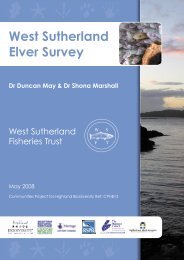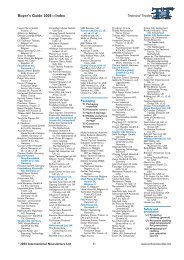NRPB and ICNIRP Guidelines
NRPB and ICNIRP Guidelines
NRPB and ICNIRP Guidelines
You also want an ePaper? Increase the reach of your titles
YUMPU automatically turns print PDFs into web optimized ePapers that Google loves.
Mobile Phone Base Stations – The Real Facts about the links with Ill-Health<br />
<strong>NRPB</strong> <strong>and</strong> <strong>ICNIRP</strong> <strong>Guidelines</strong><br />
The industry claim that because they adhere to the <strong>NRPB</strong> <strong>and</strong> <strong>ICNIRP</strong> guidelines, base stations are safe. However, the<br />
Government backed Stewart Report says there is a potential problem with emissions below the <strong>ICNIRP</strong> guidelines <strong>and</strong> so<br />
recommends a precautionary approach. The industry response has been to say we are taking a precautionary approach –<br />
we’re sticking to the guidelines!<br />
The <strong>ICNIRP</strong> guidelines do not actually consider all of the potential ill-effects of EMF. The <strong>ICNIRP</strong> <strong>Guidelines</strong> state: "In the<br />
case of potential long-term effects of exposure, such as an increased risk of cancer, <strong>ICNIRP</strong> concluded that available data<br />
are insufficient to provide a basis for setting exposure restrictions". The industry dismiss concerns about cancer by stating<br />
adherence to the <strong>ICNIRP</strong> guidelines – when these guidelines specifically DO NOT take account of the cancerous effects of<br />
base stations.<br />
Microwave Syndrome – this is a term used by scientists covering a variety of symptoms including: sleep disturbances,<br />
fatigue, irritability, headaches, nausea, loss of appetite, depressive tendency, concentration difficulties, memory loss, skin<br />
problems, visual & hearing disturbances, dizziness, cardiovascular problems <strong>and</strong> libido lowering.<br />
Studies Showing Ill-Health Effects of Base Stations<br />
1. Study of the health of people living in the vicinity of mobile phone base stations.<br />
Santini et al., Pathol Biol (Paris) [Pathologie Biologie (Paris)] 2002; 50: 369–73<br />
Found significant health effects on people living within 300 metres of mobile phone base stations. Conclusions<br />
include the recommendation: "it is advisable that mobile phone base stations not be sited closer than 300 meters to<br />
populations"<br />
2. Netherl<strong>and</strong>s Organization for Applied Scientific Research (TNO), Study for the Netherl<strong>and</strong>s Ministries of Economic Affairs,<br />
Housing, Spatial Planning <strong>and</strong> the Environment, <strong>and</strong> Health, Welfare <strong>and</strong> Sport - "Effects of Global Communications System<br />
Radio-Frequency Fields On Well Being <strong>and</strong> Cognitive Function of Human Subjects With <strong>and</strong> Without Subjective<br />
Complaints" (September 2003)<br />
Found significant effects on wellbeing, according to a number of internationally-recognised criteria (including<br />
headaches, muscle fatigue/pain, dizziness etc) from 3G mast emissions well below accepted ‘safety’ levels (less<br />
than 1/25,000th or 0.00004% of <strong>ICNIRP</strong> guidelines).<br />
3. INCREASED INCIDENCE OF CANCER NEAR A CELL-PHONE TRANSMITTER STATION<br />
Ronni Wolf MD(Sackler Faculty of Medicine, Tel-Aviv University, Israel), Danny Wolf MD(Pediatric Outpatient Clinic,<br />
Hasharon Region, Kupat Holim, Israel) International Journal of Cancer Prevention Volume 1, No. 2, April 2004<br />
This study, based on medical records of people living within 350 metres of a long-established phone mast, showed a<br />
fourfold increased incidence of cancer generally compared with the general population of Israel, <strong>and</strong> a tenfold<br />
increase specifically among women, compared with the surrounding locality further from the mast.<br />
4. Influence of the Neighbourhood of a Cellular Transmitter Antennae on the Incidence of Cancer Eger et. al. Umwelt-<br />
Medizin-Gesellschaft. 2004-Nov;17 (4): 326-335 Naila Study, Germany (November 2004) The result of the study shows that<br />
the proportion of newly developing cancer cases was significantly higher among those patients who had lived<br />
during the past ten years at a distance of up to 400 metres from the cellular transmitter site, which bas been in<br />
operation since 1993, compared to those patients living further away, <strong>and</strong> that the patients fell ill on average 8<br />
years earlier. In the years 1999-2004, i.e. after five years’ operation of the transmitting installation, the relative risk of<br />
getting cancer had trebled for the residents of the area in the proximity of the installation compared to the<br />
inhabitants of Naila outside the area.<br />
5, The Reflex Project - An EU Funded project undertaken by 12 institutions from 7 EU Countries published in November<br />
2004. The Report concluded: "Based on the methodology used <strong>and</strong> the data obtained in the REFLEX study, the<br />
findings on genotoxicity caused by RF-EMF are hard facts" This means that emissions within the <strong>ICNIRP</strong> 'safety'<br />
guidelines damage DNA causing both single-str<strong>and</strong> <strong>and</strong> double-str<strong>and</strong> breaks. As the report notes, earlier research<br />
established that DNA double str<strong>and</strong> breaks may lead to cell death, uncontrolled cell growth or cancer.<br />
The Mobile Industry claim that Cancer Clusters seen around base stations cannot be linked, as the cancers are of a wide<br />
variety so cannot be caused by the same source. The Reflex project demonstrates the opposite - the different cancers could<br />
all be caused by the base stations as the effect is on cells at a molecular level.<br />
Page 1 of 2
6. Survey study of people living in the vicinity of cellular phone base stations by Santini R, Santini P, Le Ruz P, Danze JM,<br />
Seigne M published in: Electromagn Biol Med 2003; 22 (1): 41 – 49 found incidence of Microwave Syndrome<br />
7. The Microwave Syndrome: A Preliminary Study in Spain by Navarro EA, Segura J, Portoles M, Gomez-Perretta C<br />
published in: Electromagn Biol Med 2003; 22 (2-3): 161 – 169 found incidence of Microwave Syndrome<br />
8. Subjective symptoms reported by people living room in the vicinity of cellular phone bases stations: review Bortkiewicz et.<br />
al. Medycyna Pracy 2004;55(4):345-51 found incidence of Microwave Syndrome<br />
9. Mobile public perception of risk concerning celltowers <strong>and</strong> phones - Hutter et. al. Sozial-und Praventivmedizen<br />
2004;49(1):62-6. Found that contrary to industry claims, adversaries of the antennas relay do not express unusual fears –<br />
there is no significant psychological effect<br />
10. Subjective symptoms, sleeping problems, <strong>and</strong> cognitive performance in subjects living room near mobile phone base<br />
stations - Hutter et. al. Occupational <strong>and</strong> Environmental Medicine 2006 May;63(5):307-13 found incidence of Microwave<br />
Syndrome at very low levels of exposure<br />
11. Neurobehavioral effects among inhabitants around mobile phone base stations - Abdel-Rassoul et. al. Neurotoxicology<br />
2006 Aug 1. Compared people living near mobile phone masts with a control group. Symptoms of Microwave Syndrome<br />
significantly higher amongst people living very close to the mast - headache (23.5%), memory problems (28.2%),<br />
dizziness (18.8%), tremors (9.4%), depressive symptoms (21.7%), <strong>and</strong> sleep disturbance (23.5%)<br />
12. Health Effects Associated with Mobile Base Stations in Communities – Dr Neil Cherry Assoc Prof Environmental Health,<br />
Lincoln University, Canterbury, NZ – concluded that there was “extremely strong evidence to conclude that cell sites<br />
are risk factors for: cancer, especially brain tumour <strong>and</strong> leukaemia….cardiac arrhythmia, heart attack <strong>and</strong> heart<br />
disease…Neurological effects including sleep disturbance, learning difficulties, depression <strong>and</strong> suicide.<br />
Reproductive effects especially miscarriage <strong>and</strong> congenital malformation. Viral <strong>and</strong> infectious diseases because of<br />
reduced immune system competency.<br />
In addition there have been numerous studies on the effects on animals <strong>and</strong> plants including cows, sparrows, storks, bees<br />
<strong>and</strong> trees, all showing detrimental effects in reproduction, growth or general wellbeing.<br />
Industry sources point to WHO Factsheet #304 – yet many of the above studies are from the WHO EMF database <strong>and</strong> do<br />
not support the conclusions of Factsheet #304. In addition the WHO <strong>and</strong> the <strong>ICNIRP</strong> have been criticised for being biased<br />
<strong>and</strong> overtly influenced by the mobile industry (“Conflict of Interest & Bias in Health Advisory Committees: A Case Study of<br />
the WHO’s Electro Magnetic Frequency (EMF) Task Group” – Maisch – J. Aust. Coll. Nutr. & Enc. Med. Vol. 25 No 1 April<br />
2006 pp15-17).<br />
What do Scientists Think ?<br />
The Frieburger Appeal<br />
Over 36,000 signatures have been collected including 3000 doctors noting a link between some symptoms associated with<br />
Microwave Syndrome <strong>and</strong> mobile phone base stations. The Frieburger Appeal calls on governments to promote more<br />
research <strong>and</strong> to reduce peoples exposure to base stations.<br />
The Resolution of Benevento<br />
42 scientists from 16 countries supported this resolution (International Commission on Electromagnetic Safety), claiming<br />
that the current sources of financing research skews the results, <strong>and</strong> that the arguments according to which the CEM of low<br />
intensity cannot affect biological systems do not represent current scientific opinion. They invite governments to plan mobile<br />
masts in a way to limit the exposure of the community, <strong>and</strong> urgently condemn the telecoms companies marketing to young<br />
children teenagers who are especially at risk.<br />
The Money<br />
The industry offered - <strong>and</strong> the Government accepted a whopping £22.5 billion pounds for the 3G licences - at the time that<br />
represented 2.5% of the Gross Domestic Product of the UK. The licence holders obviously have a vested interest in<br />
recouping their investment - they are hardly likely therefore to invest in research to prove that their technology is unsafe,<br />
<strong>and</strong> open themselves to compensation claims. On the other h<strong>and</strong>, the Government are likewise unwilling to invest in<br />
research which could ultimately result in them being forced to refund the £22.5 billion to the licence holders.<br />
Page 2 of 2











